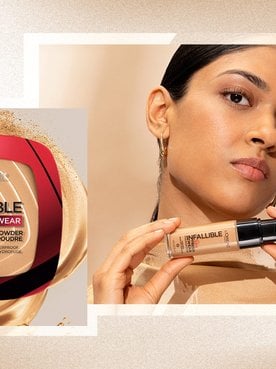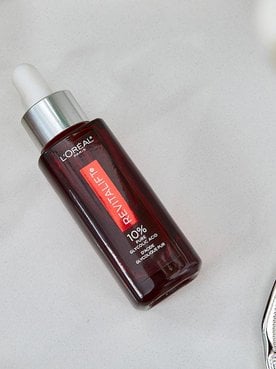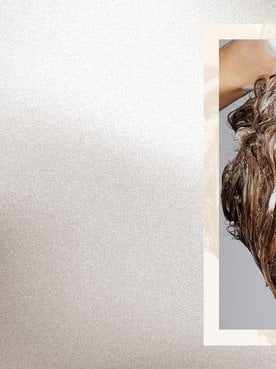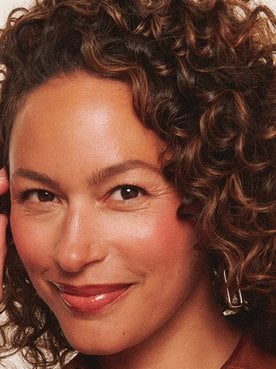If you struggle with midday shine or find your makeup tends to disappear by lunchtime, you’re far from alone—these concerns are common, especially for those with an oily skin type. Swapping your go-to base for a foundation for oily skin can make a noticeable difference in both how long your makeup lasts and how it looks throughout the day.
The best foundations for oily skin don’t just provide coverage—they can also help control excess shine, blur the appearance of large pores, and give your skin a fresh, healthy-looking finish. Ahead, we’ll break down exactly what to look for when shopping for a foundation for oily skin, plus tips on ensuring your makeup holds up no matter what the day has in store.
Shop the Products
Why Oily Skin Needs a Different Foundation
Oily skin is characterized by an excess production of sebum, the skin’s natural oil. This oil helps keep your skin moisturized, but it can also break down makeup, causing your products to separate or even slide off your face after just a few hours of wear.
Foundations specifically formulated for oily skin are designed to work with your skin’s natural oils rather than against them. They often contain mattifying ingredients that help absorb excess oil and are designed for long-lasting wear, reducing the need for touch-ups throughout the day. Some also contain blurring agents that can temporarily minimize the look of large pores (a common concern for oily skin types).
While a good foundation for oily skin should stay put throughout the day without sliding off or separating, it’s still important to prime your skin well before applying makeup. This essential first step can help diminish unwanted shine and grip your makeup into place, setting you up for a smooth, seamless application. Setting your makeup at the end of your routine—either with a setting powder or a setting spray—can also help ensure your makeup goes the distance.
What Type Of Makeup Is Best for Oily Skin?
Makeup isn’t one-size-fits-all—the “best” formula for you may not work the same for someone else. Still, there are a few key qualities that tend to work well when you’re choosing face makeup for oily skin.
For starters, opting for lightweight, water-based formulas is also a good idea, as these tend to feel more comfortable on the skin than heavier options. Additionally, if you’re prone to clogged pores, make sure your primer, foundation, and other face makeup products are oil-free and non-comedogenic—this means they’re unlikely to trigger breakouts. Lastly, if shine is a concern, consider using mattifying formulas or setting your makeup with powder to help control oiliness throughout the day.
Of course, you can absolutely use more luminous or dewy-finish products if you like a glowier look—just focus the radiance where you want it, like the high points of your face, rather than all over. This keeps your skin looking fresh, not greasy, and allows you to maintain some dimension and natural sheen while still feeling in control of shine.
Editor’s note: Not sure how to tell the difference between matte vs. natural vs. dewy makeup? Matte makeup boasts a smooth, velvety finish; natural makeup typically has a subtle sheen; and glowy makeup is luminous and dewy-looking.
Is Powder or Liquid Foundation Better for Oily Skin?
Those searching for the best foundation for oily skin will find that there are several formula types to choose from, though powder and liquid tend to be the most common. Neither is inherently better; the right match depends on how you like your makeup to look and feel, as well as your skin’s overall condition.
Powder foundations typically offer a matte finish and can help absorb excess oil, which makes them a strong option if shine is your main concern. They’re also compact and easy to reapply, making them helpful for touch-ups throughout the day. However, powder formulas can sometimes accentuate texture or settle into fine lines if the skin is dehydrated (priming your skin well can help provide a smoother, more even canvas).
Liquid foundations, on the other hand, tend to offer more flexibility in terms of finish and coverage. You can find liquid formulas that range from dewy to matte, making them ideal for those who prefer a more skin-like finish. Just note that dewy or luminous liquid foundations are more likely to slip or separate on oilier areas as the day goes on.
When to choose powder foundation vs. liquid
You should always feel free to choose whichever type of foundation you feel most comfortable with. That being said, if you need help deciding which is better for you, here are some things to keep in mind:
Consider using powder foundation if:
- You want a matte finish with built-in shine control
- You prefer light-to-medium coverage that’s easy to refresh
- Your main concern is keeping excess oil in check throughout the day
Opt for a liquid foundation if:
- You want customizable coverage (sheer to full)
- Your skin has noticeable texture that powder may accentuate
- You prefer a flexible finish that can be set with powder for staying power
Is powder foundation better for oily skin?
Powder foundations can be useful for oily skin, but they’re not always the best option. While they can help control shine and absorb excess oil, powders may emphasize texture or dryness if your skin is also dehydrated. If you have large pores, fine lines, or an uneven skin texture, a liquid foundation may be a better pick. Many liquid foundations come in long-wear, oil-free, matte, or natural-matte finishes that hold up beautifully on oily skin. Ultimately, he best choice depends on your desired coverage, finish, and how your skin looks and feels throughout the day.
What To Look for In a Foundation for Oily Skin
When choosing a foundation for oily skin, the finish and formula play a big role in how your makeup wears. A matte or soft matte finish can help balance shine, while oil-free and non-comedogenic formulas are less likely to clog pores or contribute to breakouts. It also helps to look for long-wear or transfer-resistant foundations, as these are designed to stay put throughout the day. Pay close attention to shade range and undertones, too, since the right match helps your base look seamless rather than heavy. (If you need help finding your match, check out How To Find Your Foundation Shade Match: An Expert Guide).
It can also be helpful to look for supportive ingredients. Silica and kaolin clay, for example, can help absorb excess oil, while niacinamide and salicylic acid may help keep skin clearer and more balanced over time. If you’re prone to dehydration—which, contrary to popular belief, is not the same thing as dryness—look for a foundation with hyaluronic acid to help keep your skin feeling hydrated.
Editor’s note: Knowing what to avoid is just as important as what to look for. If you have oily skin, it’s generally best to steer clear of heavy oils and very dewy or radiant formulas, as these can make oily skin appear shinier and may cause your foundation to break down more quickly.
Our Favorite Foundations for Oily Skin
Whether you’re on the hunt for a sheer, lightweight foundation for oily skin or want something suitable for a full glam moment, keep scrolling. Ahead, we’ve rounded up some of our top picks to try right now.
L’Oréal Paris True Match Super-Blendable Foundation
This lightweight foundation for oily skin ticks all the boxes: It’s non-comedogenic, oil-free, and fragrance-free; suitable for all skin types; and offers medium coverage with a flattering, skin-like finish. Plus, the hydrating formula comes in 47 shades spanning warm, cool, and neutral undertones equally. If you need help nailing down which shade is right for you, we suggest checking out our article How To Find Your Perfect L’Oréal True Match Foundation and Concealer Shades.

Shop the Product
L’Oréal Paris Infallible Skin Ink Up To 48H Longwear 2-in-1 Foundation Concealer
If you’re on the hunt for a matte foundation for oily skin that doesn’t feel heavy on your face, this hybrid formula is one to try. It covers like a concealer but has a fluid, weightless texture similar to ink, so it feels undetectable on your skin. Plus, it’s incredibly long-lasting—once set, the waterproof, heatproof, and humidity-proof formula wears for up to 48 hours without caking, creasing, or transferring. Keep in mind that you’ll want to apply it in sections, rather than all at once, to ensure a seamless, undetectable blend.

Shop the Product
L’Oréal Paris Infallible 32 Hour Fresh Wear Foundation
This liquid foundation works well for most skin types, but it’s especially flattering on oily skin thanks to its lightweight, oil-free formula. It delivers a natural finish that looks balanced—not too shiny and not too flat—and stays put for up to 32 hours without smudging or transferring. Plus, it’s buildable, so you can adjust the coverage from medium to full depending on the look you’re after.

Shop the Product
L’Oréal Paris Infallible Pro-Matte Foundation
If you have oily skin, you may also be dealing with visible pores—and the right base can help smooth their appearance. The L’Oréal Paris Infallible Pro-Matte Foundation is a great foundation for oily skin because its creamy formula applies evenly and settles into a soft demi-matte finish that helps minimize the look of texture. It lasts for up to 24 hours and keeps shine in check without looking flat. Apply it with a brush for fuller coverage, or use your fingers to blend it out for a more natural, skin-like finish.

Shop the Product
L’Oréal Paris Infallible Up To 24H Fresh Wear Foundation In a Powder
If you prefer powder foundations, this one is a standout—it delivers lasting coverage without ever looking heavy or chalky. The weightless formula applies like a liquid and sets to a blurred matte finish that still feels breathable and comfortable. It’s also oil-free and non-comedogenic, making it one of the best powder foundations for oily skin—and a solid option for those who are acne-prone, as well.

Shop the Product
L’Oréal Paris True Match Radiant Serum Foundation
Choosing a water-based foundation for oily skin is often a good idea—the lightweight base can help keep your skin feeling hydrated without weighing it down. There are plenty of formulas to choose from, but for days when you want just a hint of coverage, we recommend this serum-foundation hybrid. The tinted formula fuses skincare ingredients like hyaluronic acid with sheer mineral pigments for lightweight coverage that looks radiant and natural. Plus, the skin-focused serum helps hydrate and smooth skin over time for a more radiant, luminous-looking complexion.

Shop the Product
6 Makeup Tips for Oily Skin
If you want to keep your makeup looking fresh all day, here are some makeup tips for oily skin to keep in mind.
1. Prep your skin
Don’t buy into the myth that moisturizer is optional if you have oily skin: all skin needs hydration to look (and feel) its best. If you have oily skin, however, you’ll want to reach for a lightweight, non-greasy formula. We like the L’Oréal Paris RevitaLift Derm Intensives Micro Hyaluronic Acid + Ceramides Line-Plumping Water Cream. The water-based formula absorbs quickly, leaving the skin feeling hydrated and plump, not greasy. Plus, it won’t clog your pores, so you don’t have to worry about waking up to an unexpected breakout.
2. Always use makeup primer
When you have oily skin, chances are you’ve experienced a midday makeup meltdown before. Applying a makeup primer before layering on your foundation can help your makeup grip better, making it less likely to slide off. We suggest starting your makeup routine for oily skin with a primer that’ll help your makeup grip and minimize shine. Try the L’Oréal Paris Prime Lab Up to 24H Pore Minimizer: It contains a 1% complex of exfoliating acids and provides an instant blurring effect for a smooth, velvety-looking base.
Shop the Product
3. Opt for mattifying makeup
As we mentioned above, both powder and liquid foundations have their merits—it’s up to you to determine which type of foundation best suits your needs. That being said, if keeping oiliness at bay is your main priority, we suggest reaching for a matte foundation for oily skin. These will help control the excess shine that can interfere with your makeup’s staying power. If matte makeup really isn’t your thing, then try a natural-finish foundation for a balanced, healthy-looking complexion that’s neither flat nor visibly oily.
Keep in mind that for a seamless makeup application, you’ll also want to consider the formulas of the other face products you use. Liquid and powder makeup layer equally well over liquid foundation, but if you opted for a powder foundation, we suggest staying on theme and using powder products for the rest of your routine. Layering liquids or creams over a powder base could result in a patchy, disjointed finish.
4. Don’t skip setting spray
To keep your look in place all day, finish your makeup with a spritz of the L’Oréal Paris Infallible 3-Second Setting Mist, spraying it in a circular motion to cover every inch of your face. The lightweight, non-greasy setting spray helps lock your makeup into place so it resists transferring, caking, and creasing for up to 36 hours.
5. Touch up with blotting sheets
If you find your skin looking shinier than you’d like, you can use a blotting sheet to help minimize the appearance of excess oil. These absorbent papers help soak up excess oil to mattify your skin—without disrupting your carefully-applied makeup. Throw a pack in your purse for midday touch-ups, and you should be able to tackle any shine that crops up throughout the day.
6. Take off your makeup before bed
You’ve likely heard this one before, but taking off your makeup every night isn’t just a good habit to form—it’s a must for healthy-looking skin. Leaving your makeup on overnight can contribute to irritation, clog your pores, or even lead to breakouts. To set your skin up for success, wash your face each night with a gentle cleanser designed to remove dirt, oil, and makeup (we love the L’Oréal Paris RevitaLift Radiant Smoothing Cream Cleanser). Follow up with a targeted facial serum and your favorite nighttime moisturizer to help seal in hydration while you snooze.
Shop the Products
Common Foundation Mistakes for Oily Skin (and What To Do Instead)
Choosing the right foundation for oily skin is only part of the equation—how you prep and apply it makes a big difference in how your skin looks and feels throughout the day. Here are some common pitfalls and how to fix them.
- Choosing the wrong finish: Overly dewy or radiant formulas can amplify shine and make foundation appear greasy as the day goes on.
The fix: Stick to matte or demi-matte formulas that help control shine without looking flat.
- Skipping makeup primer and setting spray: Without primer, foundation has nothing to grip onto, which makes your makeup more likely to slide off your face. Primer can also help smooth the look of imperfections, such as large pores or blemishes. Setting sprays and powders, meanwhile, helps “lock” your look into place.
The fix: Apply an oil-free, mattifying primer to create a smooth base and help your foundation adhere better. At the end of your routine, mist your face with setting spray or use a setting powder to help extend wear time.
- Mixing incompatible formulas: Layering products with different textures (for example, a liquid blush over a powder foundation) can cause pilling or separation.
The fix: Use products formulated to work together and avoid layering liquids over powders.
- Applying too much product: Building coverage everywhere can emphasize texture, settle into pores, and break down faster on oily areas.
The fix: Build coverage gradually—start with a light layer and add only where needed to prevent caking and excess oil.
- Neglecting skincare: It’s easy to assume oily skin doesn’t need moisturizer, but the opposite is true—in fact, skipping moisturizer can make your skin more oily in the long run.
The fix: Keep oily skin balanced with a proper routine—cleanse, exfoliate occasionally, and moisturize with a lightweight, non-comedogenic lotion or cream.
Next Up: The Best Face Primers, Based On Your Skin Type
Photo courtesy of L’Oréal Paris







